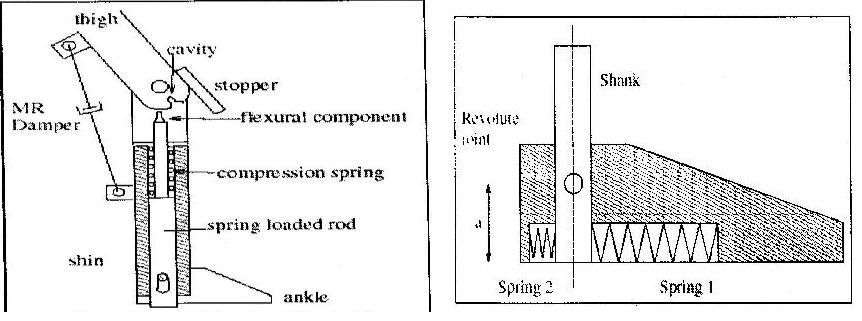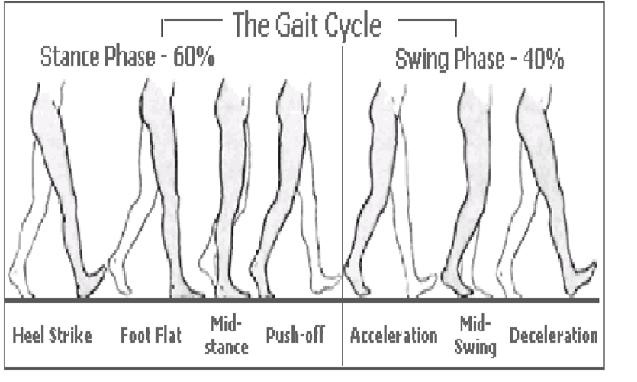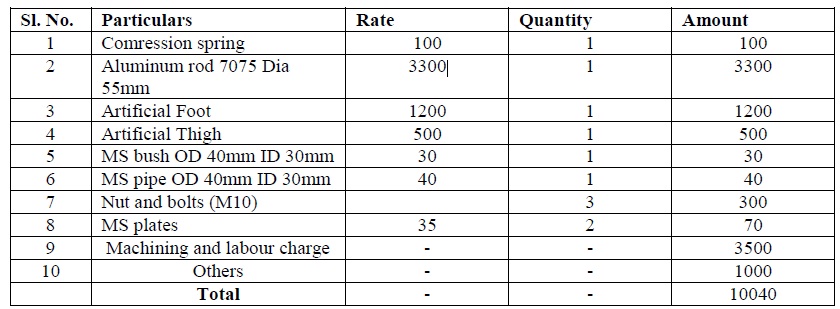





Published on Nov 30, 2023
In spite of many path breaking advances in medicine, little has been done to address the needs of amputees who constitute nearly 5% of the population of Third World countries. A majority of the population of these countries are already worn down in their struggle to make ends meet and invariably end up with no means to support themselves upon amputation. The products available to help them lead a normal life require high maintenance and are built with sophistication making them far too expensive. The paper is a report of the analysis, design and fabrication process of artificial limb for Above-Knee Prosthesis. We are confident that our design is costeffective without compromising on gait.
Artificial limbs or prosthesis are a substitute for amputees who have lost their limbs due to injury or disease. Amputations leave stumps in various stages of damage depending on the reason of amputation. Type of limbs to be used is determined by the extent of amputation and location of missing extremity. Mechanical devices have been used to provide assistance to persons with amputation in performing normal functions. Although these mechanical devices provided certain degree of improvement to amputees, there were certain limitations of mechanical devices.
In conventional design for above knee prosthetic device involves use of a simple pivot at the knee, a damper that damps the swing motion of the leg. There are several short comings on such devices which leads to greater requirement of energy for the amputee. The absence of flexion and extension during the stance phase creates vaulting action for the amputee, which causes energy loses. Similarly lack of an articulated ankle also leads to gait defects. For passive above knee prosthetic device, the transition of the limb from the stance phase to swing phase must be smooth. This problem can be addressed by integrating a suitable design for the knee with the prosthesis.
At the beginning of the stance phase, the spring loaded rod moves through the hollow tube due to weight and the flexural component sinks into the cavity on the lower femur surface and thus locks the whole system.

Between heel strike to foot flat, the spring 1 in the ankle acts as cushion to reduce impact of foot flat and spring 2 acts as storage of energy as foot moves forward.
At heel off, the weight stops acting on the spring loaded rod and rod comes out of the cavity, due to compression spring. The knee thus becomes revolute.The hyper extension motion of the knee is prevented by using a simple stopper.

Figure 2.3 Gait cycle[1]
Prosthetic design involves making a replacement of a missing body part of the appropriate shape and size. The prosthesis must be comfortable, functional, and cosmetic (appearance of the prosthetic device, including visual appearance, smell, sound). The prosthesis should take into account the client’s general health, weight, activity level, and motivation so as to set realistic goals. The patient’s residual limb length, shape, skin condition, circulation, range of motion, and maturation should also be taken into account. Since prostheses are expensive and many insurance companies provide limited reimbursement or a single artificial limb, cost may also be a factor. The principal function of the residual limb is to serve as the lever to power and control the prosthesis. The prosthetic socket must support the patient’s body weight and hold the residual limbfirmly and comfortably during all activities. As such, the prosthetic socket should be designed to support the residual limb tissues, facilitate control of the prosthesis during stance and swing, provide suspension during swing, and facilitate alignment of the artificial limb. Near-total contact between the distal limb and socket is required to aid proprioceptive feedback and prevent edema and skin problems.
Since the design of the prosthesis varies with amputation level, prosthetic design will be reviewed for the aforementioned lower extremity amputation levels. Since the primary levels of lower extremity amputation are transtibial (54 percent11) and transfemoral (33 percent11), the prostheses for these amputation levels will be presented in greater detail.

Prosthetic legs are artificial limbs that are used in cases of amputation. Either one or both legs may be subjected to amputation for a variety of medical reasons. Amputations can be performed above or below the knee, depending on medical conditions. A variety of factors can make the use of a prosthetic leg easier. Typically, people who are younger and do not have weight problems are better able to adapt to their prosthetic legs. Stamina, bone structure and motivation are also factors. Not everyone who has a leg amputation wants to wear a prosthetic leg, and not everyone with two leg amputations wants prosthetic leg replacements. There are, however, advantages to using prosthetic legs
The Atlas of Limb Prosthetics: Surgical, Prosthetic, and Rehabilitation Principles conducted a study to compare the energy expended when walking with a single prosthetic leg and walking with crutches. The use of crutches with double amputees was not studied. When the prosthetic legs are well fitted and the patients have satisfactory gaits, patients expend less energy walking with prosthetic legs than when walking without prosthetic legs and using crutches
For people with two leg amputations, the choice is between prosthetic legs and a wheelchair. Some patients, even those with single amputations, prefer the comfort of a wheelchair and choose to forgo prosthetic legs. But prosthetic legs allow amputees the option of going up stairs. Also, there are areas that are not accessible by wheelchairs, although there has been an increased awareness of making areas available to the handicapped. Prosthetic legs provides a greater sense of independence.
People can gain a better psychological outlook on life by mastering the use of prosthetic legs, whether they have one or two prosthetic legs.Amputees feel less discomfort with their conditions when wearing prosthetic legs because of the ability to blend in better with the crowd. Also, people who do not have the opportunity to wear prosthetic legs feel cheated and can become bitter and frustrated.
Our product is cost effective than the available products in the market.
For years, prosthetic technology has been limited—both in terms of functionality and the materials they are made from. In addition, many artificial limbs are heavy, making them burdensome to use. In the past decade or so, however, prosthetic limbs have evolved substantially, and, in many cases, as transitioning towards bionics. Engineers have pushed the boundaries of what was possible in prosthetics using a variety of new materials, electronics, and techniques, such as integrating implants directly with muscle fibers.
Believe that ways will be developed that allow people to re-connect with their arms and legs without being amputated, which can be very useful to the paralysed and the disabled. Already, the latest technology is capable of enhancing people.As we design artificial leg which operates by its own using human weight and the project what we are doing will reduce the cost of artificial legs considerably so that people with poor financial background can easily afford it.
[1.] Chester, C.H., Atha, T. (1945) Amputation Prosthesis. Romm, Sharon. (1988) Plastic and Reconstructive Surgery.